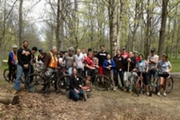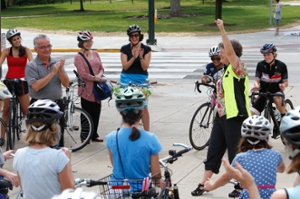Reframe Podcast: Episode 15

EHS Peddles Public Health though Grass Roots Community Activism

We explore new movements to improve public health . . . literally, as kinesiology and health students get involve in civic engagement to improve the bikeability of their local community.
James Loy:
This is Reframe, The podcast from the College of Education, Health and Society on the campus of Miami university.
In this episode, we explore new movements to improve public health . . . literally, as kinesiology and health students get involve in civic engagement to improve the bikeability of their local community.
On a normal day in Oxford, OH, cyclists cruise throughout the small college community that many call home. Even during the slower summer months, faculty, residents and even some students, will ride, to and fro, on bike lanes that run straight across town and right through Miami University.
Here, as in many communities, a burgeoning biking culture is growing. And though many may not realize it, the bike lanes they use represent far more than just lines running parallel to a few roads.
They are, in fact, part of an ongoing health-based research and community engagement project between the local township, Miami’s College of Education, Health and Society (EHS), and its kinesiology and health students.
Here’ s Dr. Helaine Alessio, EHS professor of kinesiology and health:
Helaine Alessio:
The history to get that bike lane was a big deal. And there were some students involved. We had to make a case that there would be a need for it. So students did some counting. Our students have been involved with tracking usage and they found that . . . the good news is that the bike lane usage, except for the winter months, is significant and actually it’s on the rise.
James Loy:
So, if you build it, she says, they will come. If you put bike lanes in, they will use them.
On the surface, these the bike lanes were a great resource for bikers and commuters. But below the surface, if we look a little deeper, they also become part of the interconnected cultural and contextual variables that can affect wellness on community-wide levels. Individual diet and exercise matter of course, but they are far from the whole story.
According to Alessio, the health of a community is highly dependent on the health of the environment, which includes well-known factors such as pollution. But emerging public health concepts such as active transportation and the “built environment” are now also being closely examined.
The built environment refers to human-made spaces and places like parks, sidewalks, gardens, and transportation systems, among others, which can all influence public health. Some communities have more access to such resources, while others don’t.
Those that do are better able to reap the associated health benefits, and improving a city’s bikeability is just one example.
Alongside the obvious boosts to individual physical fitness, the benefits to biking also ripple outward. Typically, more bike usage means less automobiles, which leads to less road congestion, less construction, and less accidents. Economically, research has correlated it with revenue boosts to local business, individuals who save on car costs, and even increased property values for homes with easy trail access.
Environmentally, it also leads to improved air quality through reduced carbon emissions, which Alessio and her students have already studied.
Helaine Alessio:
Just in little Oxford, alright. Just in little Oxford. We did this count of the average number of bikes . . . and this was a couple of years ago. The average number of bikes counted with the bike lanes is actually even more now. So we did this prediction of average number of single occupancy vehicle miles replaced by each bike. And we are only talking about two. One each way on the bike lanes. But it is possible there is more. It could be double that. So I am just saying we were very, very, very conservative. So it all comes out to saving approximately four metric tons of carbon dioxide per year.
James Loy:
That’s with just 24 bikes per hour, riding just two miles a day of riding instead of driving
And given the moderate nature of this study, the real number is likely far higher, as it would be in much larger in communities with far more traffic. But before this, or any other benefit can take effect, the proper infrastructure has to be in place as well as the people willing to make it happen.
And in Oxford, the bike lanes were only the first step.
Karly Geller, EHS assistant professor of health promotion, also enlisted students to survey nearly 700 bikes secured to various racks around 84 campus buildings. The Students assessed the condition of bikes, and looked at which were rideable, which were not, and why.
Helaine Alessio:
They are helping to track the data and to do these calculations. They are helping to verify numbers. And they are thinking of other things. Like what else might influence people who might want to ride a bike. Temperature? Whether it’s raining? Gas prices? Maybe another thing is whether or not there is a bike rack that you can secure a bike to, maybe. Or maybe its whether your bike is working because it’s been out in the rain for two weeks and now the chain is rusty. And then on and on and on.
James Loy:
Off campus, this has also led directly to the project’s most recent phase, which includes tracking bike rack usage in Oxford’s primary business district. And through an interdisciplinary partnership with Miami’s College of Creative Arts, plans are in place to install several functional and creative bike rack sculptures around town.
Designed by Miami art student David Stellmach, the new bike racks will give cyclists even more accessibility. And so far, three locations have been identified and 3D models of proposed sculptures have already been created. The Oxford Community Foundation will fund the project and various local businesses are also tentatively onboard.
But before the new bike rack sculptures can become a reality, Alessio and her students must again navigate the world of civic engagement and acquire approval from the city council. Building codes, available sidewalk space, various engineering logistics, and more, must all be considered first.
Helaine Alessio:
When they had the discussion at city council, whether or not to approve the bike lanes, those meetings were packed. And there were some students. There were several students at those meetings. And it was a great example of them seeing how grass roots community activism can help to work with the way community wants. You can’t just sit back and wait for somebody else to do it. And they learned that. They saw it. And they also saw the push back. So students learned that there is give and take. And then if you want something, you have to document, provide evidence, and make a strong case for it.
James Loy:
So, perhaps, even more significant than the practical benefits they are bringing to their college community, may be the breadth of first-hand experiences these students are also acquiring along the way. After graduation, many will pursue careers in various health-related fields, and soon they will have communities of their own to improve as professionals themselves.
But until then, they now have the opportunity to explore the multitude of factors that can influence public health, what it takes to introduce even seemingly small and innocuous changes to the built environment, and how it’s all connected.
Helaine Alessio:
You may not know of it coming in, but you have to be aware of it. You have to be aware of health from a variety of angles. Like, if you think that health is only about going out and jogging and eating right and that’s pretty much it, you don’t get it.
James Loy:
And that’s because there are so many more things involved. Things like socioeconomic status, like ethnicity, and, clearly, where you live.

